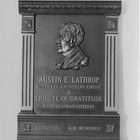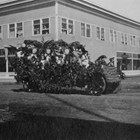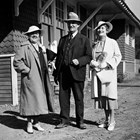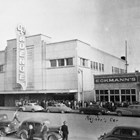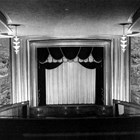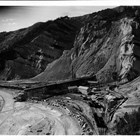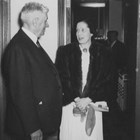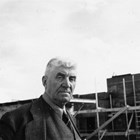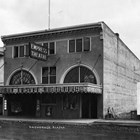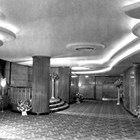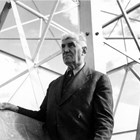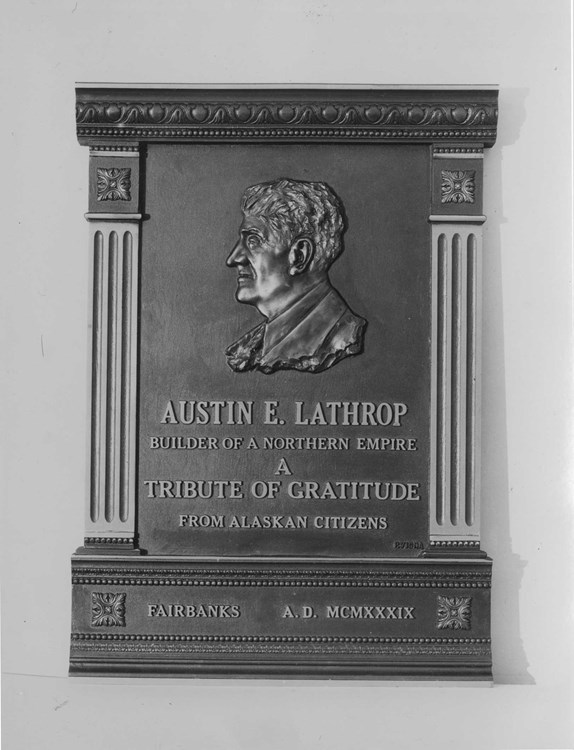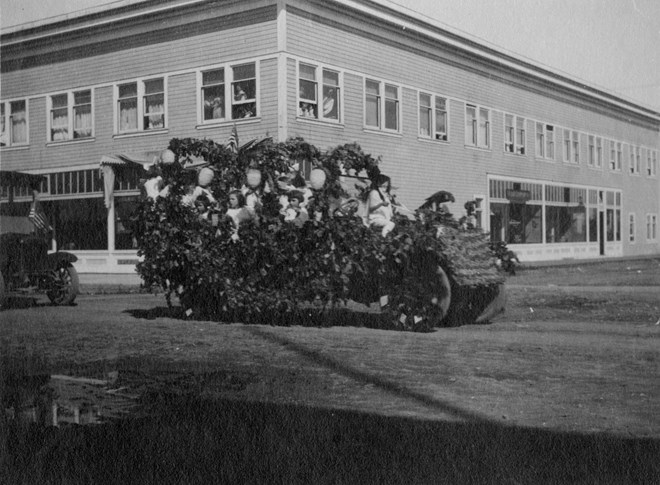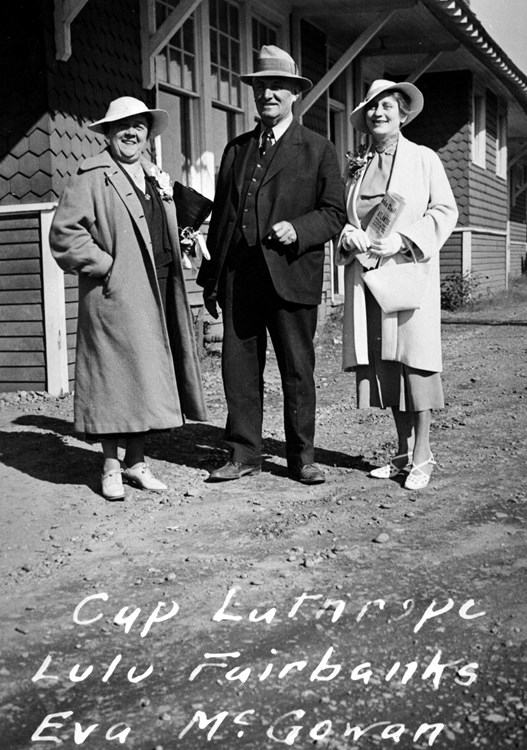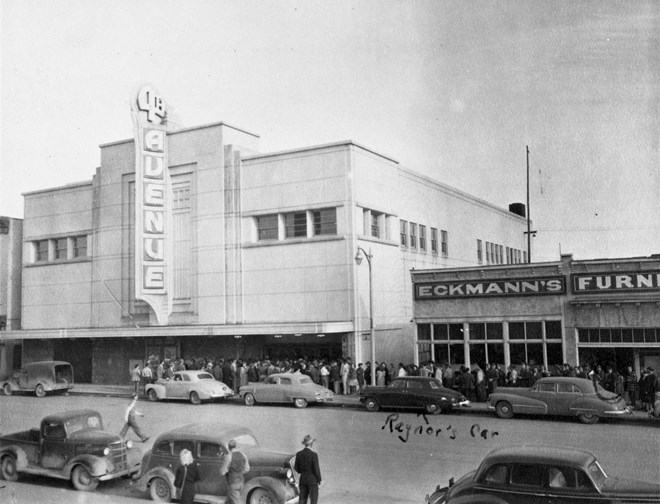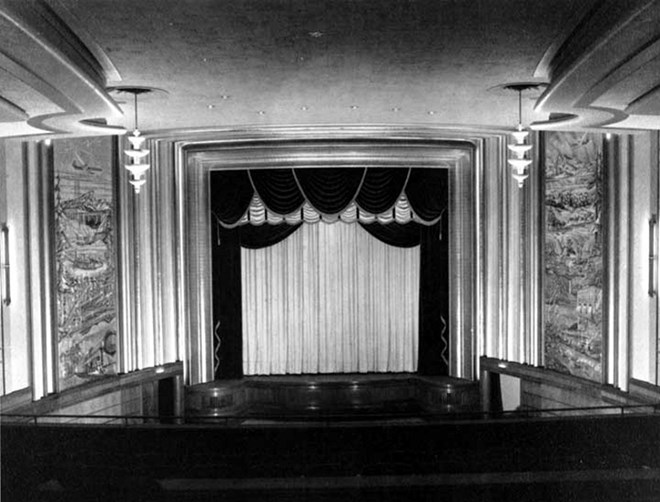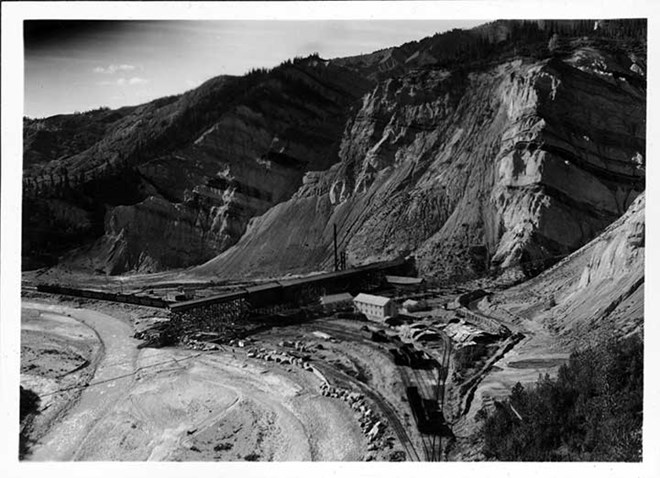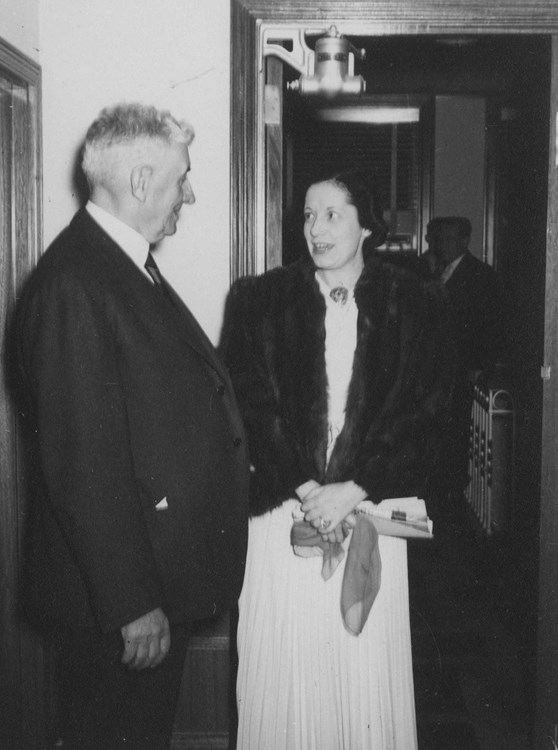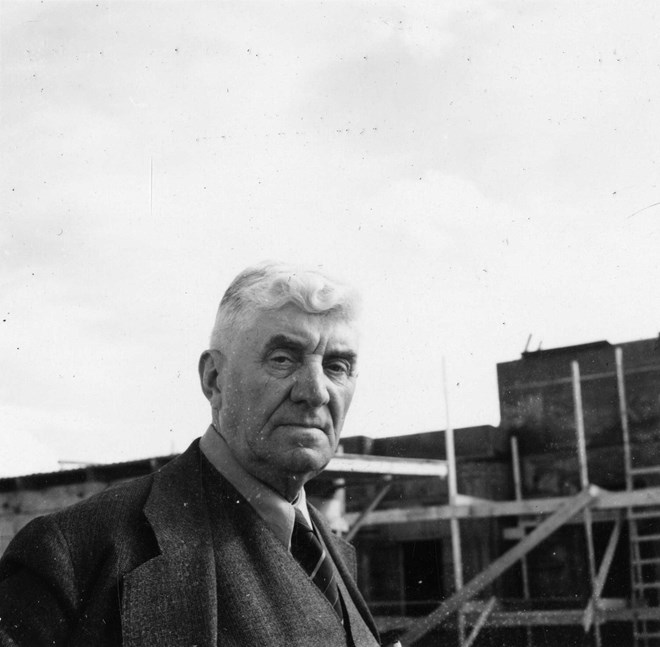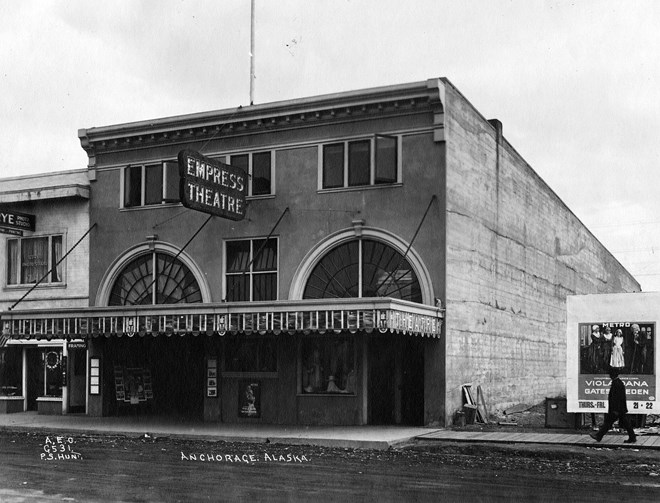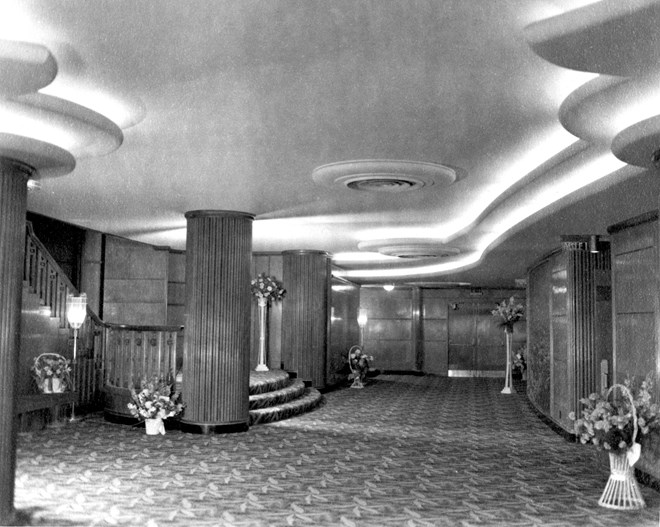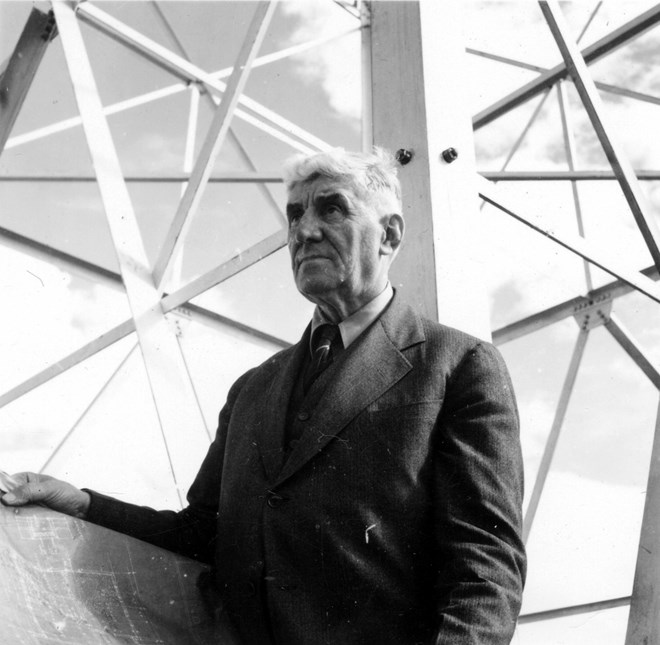Lathrop, Austin Eugene "Cap"
1865-1950 | Business Entrepreneur, Self-Made Tycoon, and Developer
Austin E. “Cap” Lathrop was the single most powerful businessman in the Territory of Alaska and its richest resident. Remembered as a man of great drive, vision, and the capacity for work, Lathrop has been called an “industrialist,”1 “the builder of modern Alaska”2 and “Alaska’s first homegrown millionaire.”3 He was in the forefront of development in construction, transportation, communications, and mining. While an opponent of Alaska statehood, he built a substantial portion of its pre-World War II infrastructure that facilitated the admission of the forty-ninth state into the Union. Over the course of a fifty-year career in the Pacific Northwest, forty-five of them in Alaska, Lathrop gradually extended his diverse interests to Cordova, Suntrana, Fairbanks, Anchorage, and other parts of Alaska. He owned a chain of movie theaters throughout the Territory, a coal mine at Suntrana, a newspaper, and two radio stations in Anchorage and Fairbanks. Other enterprises included banks, major buildings, apartments, and a model salmon cannery. In 1896, he came to Alaska as the business manager and, then, skipper of the L.J. Perry, and foresaw the opportunities for shipping and freighting during a gold rush on Cook Inlet immediately prior to the start of the Klondike gold rush.
Early Years
Austin Eugene Lathrop was born on October 5, 1865, in Lapeer, Michigan, to Eugene and Maria Parson Lathrop. His father was a teamster and a farmer. He was still a baby when the family moved to Harrisville, Michigan. He completed elementary school but quit school early in the ninth grade after being wrongfully expelled for vandalism for damages caused when tampering with a water heater. He chose to help his father haul wood instead of returning to school when the real culprit was identified.4 When Austin was sixteen years old, he moved with his family to Ashland, Wisconsin. In Ashland, he went to work at the age of fifteen, pulling stumps with his own team of horses. He worked in a variety of other jobs relating to the draying and contracting business with teams of horses.5
Great Seattle Fire (1889)
Lathrop left his close-knit family in Ashland after learning of the Great Fire of Seattle (June 6, 1889).6 Virtually overnight, swarms of people converged on Seattle seeking good jobs. Over the next year, job seekers and their families arrived at the rate of 2,000 per month. Seattle’s population doubled from 26,740 to 42,837 people. Development and construction continued unhindered and Seattle was called the “boomingest place on earth.”7
Lathrop recognized that the disastrous Seattle fire that destroyed the city’s business district (today’s Pioneer Square) presented him with an opportunity to participate in the rebuilding of the Puget Sound metropolis. While the fires were still smoldering, he left Ashland within twenty-four hours and was on his way to Seattle. He wired his father for several teams of draft animals trained to haul Wisconsin lumber. He had already lined up enough jobs as teamster removing building debris and clearing the land for rebuilding. He pushed his business with such energy that in a short time he was working with forty teams and became known as “the boy contractor.”8
Developing Anacortes, Washington
After Seattle had been largely rebuilt by 1890, Lathrop accepted a new challenge. By the following year, he had moved his equipment and business north of Seattle to Anacortes, Washington on Fidalgo Island, proclaimed to be the prime future port on Puget Sound. He secured contracts to clear the townsite, graded streets, and built the electric railroad from Anacortes to Fidalgo City, where land needed to be cleared. Prospects were so promising that he sent for his parents and two sisters to join him. He made plans to marry eighteen-year old Maude Woodcock, who was his special guest on the inaugural run of the Anacortes Railroad in the spring of 1893. The rail line was constructed for the distribution of island farm crops to growing mainland markets. After the railroad dedication, he leased six hundred acres on Protection Island, some twelve miles from Port Townsend, and built homes for himself and his family.9
Lathrop started several businesses on the family compound, which included docks, a hunting resort, and a model poultry farm. These enterprises developed into one of the region’s showplaces, where he entertained many famous visitors, including former President Benjamin Harrison. The poultry farm, with 5,000 laying hens and 2,500 chicks hatching every three weeks, used the new practice of date-stamping eggs for market to indicate their freshness.10
In the spring of 1893, a precipitous drop in U.S. gold reserves triggered a national economic depression. Since Seattle was still rebuilding from the 1889 fire and depended heavily on Eastern capital, the King County and Puget Sound region plunged into a deep economic depression that would last four years until the start of the Klondike gold rush. On May 5, 1893, the New York stock market declined dramatically, setting off a nationwide panic and economic depression that swept across the United States and then spread to the Pacific Northwest. The ensuing Panic of 1893 hit Seattle hard. The jobless, including Lathrop, fled Seattle, Portland, and other urban areas hoping to find work elsewhere.11
Lathrop’s prosperity was ruined by the Panic of 1893. Eastern investors in the Anacortes Railroad declared bankruptcy and never paid him for the work completed on the railroad line. He was forced to give up the buildings and properties on Protection Island and to move his family to a small house in Seattle. Lathrop, without work and in debt, abandoned plans of marriage and even pawned the gold watch that Maude Woodcock had given him to get money for food.12
Alaska
In 1895, Lathrop embarked on a new adventure that marked the beginning of his Alaskan ventures. One day in the fall of 1895, Lathrop was in a Seattle waterfront saloon hoping for a free meal when he met a long-time acquaintance, Captain Kelly, a “salted maritime man.”13 Kelly had learned from some prospectors of a new gold discovery in the Turnagain Arm section of Cook Inlet in Alaska. Both men became very interested, not in prospecting, but in the opportunities that shipping and freighting could bring during a gold rush and considered obtaining a boat. Lathrop remembered the L.J. Perry, a small two-masted steam schooner that had transported hay for his horses while he was working in Anacortes. Although he had no money, his credit was still good. Through a loan from A.E. Barton of the Fry Meat Packing House and John O’Neil, Lathrop bought the L.J. Perry. Captain Kelly signed on as skipper. O’Neil served as the chief engineer and Lathrop, with no boating experience, became the purser and business manager. The small vessel was placed into dry dock at Ballard over the winter to prepare for rough going in sub-Arctic waters. On April 6, 1896, a year before news of the Klondike gold strike reached Seattle, the L.J. Perry left Galbrath Dock with a cargo of supplies bound for the Alaska Commercial Company in Kodiak.14 Their initial voyage to Kodiak led to years of steady success.
In 1896, Lathrop and his partners freighted and traded extensively along the coast from Southeastern Alaska and around the treacherous waters of Cook Inlet.15 The L.J. Perry had a shallow draft and was ideal for areas on Turnagain Arm and Cook Inlet that were too dangerous for larger ships, which would unload cargo at Tyonek.
Lathrop returned to Seattle in the winter of 1896 with sufficient financial resources to marry, but found that Maude Woodcock had married someone else. He persuaded his father to come to Alaska to open a store at Sunrise on Turnagain Arm. Lathrop obtained his master mariner’s license in 1897 and bought out his partners, becoming owner, business manager, and captain of the L.J. Perry for the next four years. It was this connection with the sea which won Lathrop the title of “Captain,” and he has since been known as “Cap.”16
Although the news of the gold strikes in the Klondike led many miners in Cook Inlet to stampede to the new fields, Lathrop remained in southcentral Alaska. In 1898 he hauled supplies and horses for the Glenn Expedition, a small detachment of U.S. Army troops under the command of Captain (later Major General) Edwin F. Glenn, which had orders to probe the Chugach Mountains for routes to the Copper and Susitna Rivers and to seek the best way to the Yukon River.17
Valdez and Cold Bay
In 1901, Lathrop moved to Valdez and, with the assistance of San Francisco investors, organized the California-Alaska Mining and Developing Company to prospect for copper in the Kotsina district. Copper was found, but could not be profitably mined because of the lack of transportation facilities to move it to market.18
While wintering in Seattle that year, Lathrop met Mrs. Lillian McDowell, an attractive widow with a fourteen-year old daughter, Cleo McDowell. They accompanied Lathrop back to Alaska. On February 18, 1901, in the first wedding in the history of Valdez, Captain Austin E. Lathrop and Lillian McDowell were united in matrimony at the residence of the Reverend D.W. Crane. The couple then traveled east, visiting the Pan American Exposition in Buffalo, New York. On this trip Lathrop convinced J.H. Costello, a wealthy Buffalo capitalist, to bankroll an oil drilling project in Dry Bay in Cook Inlet. The Lathrop family returned to Alaska, spending the winter of 1902-1903 in Valdez. Lathrop and Costello drilled several wells at Dry Bay but the project was unsuccessful.
The Lathrop family spent the spring of 1903 in Cold Bay, where Lathrop drilled unsuccessfully for oil. He took the first standard oil rig in the Territory to prospect for oil in the interest of the Costello Oil Land Company. He attempted to make a comfortable home for his wife and stepdaughter in the small oil boom settlement, but the Alaska Peninsula did not suit the socially active Miss Cleo, who persuaded her mother to relocate to Seattle. He returned to the Alaska Peninsula in the summers of 1904 and 1905 to drill near Lake Becharof without success. He finally returned to Valdez in late August. By this time Lathrop had sold the L.J Perry. He became a teamster again, with a contract to haul and lay ties for the new Copper River and Northwestern Railway in 1906.19
Developing Cordova
Lathrop visited California in the winter of 1906-1907, promoting a copper mining project on the Kotsina River, a tributary of the Copper River. Although there were promising finds, this project did not seem to gather much traction. By 1908, he was a partner, and then full owner, in the Alaska Transfer Company, a freight business in Cordova, Alaska, which was developing as the terminus for the Copper River and Northwestern Railway. In February 1910, he learned of his wife’s death from a lingering illness in a house he had built for her, where she had been provided with round-the-clock professional care.20
Lathrop gradually expanded his interests to become one of the most prominent businessmen in Cordova. He started the Alaska Transfer Company and enjoyed a monopoly in the coal and transfer business. He followed the business practice of paying the freight bills of his customers when hauling their merchandise from the dock to their stores, collecting both the drayage and the freight on the monthly statement. He became a major stockholder and director in Sam Blum’s First National Bank of Cordova. He also represented the Olympia Brewing Company and the Pacific Alaska Navigation Company. Other interests were a movie theater, lumber yard, ice house, and a fish saltery. In 1917, he built a large apartment house.21
Cordova Coal Party (May 4, 1911)
In 1911, Lathrop was elected as mayor of Cordova. He served only one term, although he remained on the city council through 1914. The salient event of Lathrop’s tenure as mayor was the “Cordova Coal Party” or anticonservation protest based on the Boston Tea Party against the federal closure of Alaskan coal lands to development, which required Alaskans to buy expensive Canadian coal. Several years earlier, President Theodore Roosevelt feared that Alaska’s immense coal reserves would be used to benefit only a few corporations. He prohibited additional coal mining on public lands in Alaska. Coal imported to Alaska cost $15 per ton while the cost to mine local coal was $3 per ton.
On May 4, 1911, three hundred Cordova businessmen and citizens boarded a ship moored dockside with coal from British Columbia and shoveled almost a ton of coal into the harbor.22 Local citizens compared their actions to the Boston Tea Party, a political protest when angry colonial citizens dressed as Indians dumped tea overboard to protest British taxes, and called the affair the Cordova Coal Party.23 After demands were made to disband or be charged with rioting, the group broke up. Mayor Lathrop contacted Territorial Governor Walter E. Clark, who was in Washington, D.C., to request assistance. In the days following the Coal Party, there was great fear of further demonstrations. The federal government, however, did not change its coal policies. In nearby Katalla, the former chief of the U.S. Forest Service, Gilford Pinchot, was reportedly burned in effigy by an angry mob.24
Early Anchorage Interests
In 1915, Lathrop extended his Alaska Transfer Company to Anchorage to handle the business created by the construction of the Alaska Railroad. He located his office in the Lathrop Building (4th Avenue and H Street). After a second story was completed on the building about year later, he lived in one of the apartments. He became a director of the Bank of Anchorage, which later merged with the Bank of Alaska, later the National Bank of Alaska. He was a director of the Anchorage-Willow Creek Mining and Development Company. Interestingly, it was through his efforts that the Alaska Labor Union was able to build their Labor Temple on 4th Avenue.25
The Chechahcos (1923)
In the summer of 1922, Lathrop formed Alaska Motion Picture Corporation and, as president, oversaw the 1923 production of The Chechahcos.26 His plan was to produce a motion picture for national distribution to tell the true story of the Alaska gold rush. By November, a 7,000 square foot studio was being built at the end of Third Avenue in Anchorage. The arrival of the actors on March 8, 1923 was the excuse for a town-wide party. Many of the scenes were filmed in Mount McKinley National Park and in Girdwood. Interior and other scenes were shot in Anchorage. When released in Alaska late in 1923, it played to packed houses throughout the Territory.27 The film was shown nationally but was not a commercial success in its stateside showings. Predictions at the time about its unpronounceable title and criticisms about its “hokey” plot to outside audiences proved to be correct. It remains one of the most impressive examples of regional filmmaking and was the first feature-length movie to be made entirely in Alaska. Lathrop was never again involved with producing motion pictures.28
Other Business Interests
Lathrop developed a chain of movie theaters in the early 1910s. The motion picture was an eagerly devoured form of entertainment, and provided a social outlet. Starting with the Empress at Cordova in 191129, he built Anchorage’s Empress (1916) and Fourth Avenue (1941-1947)30, and the Empress 31 (1927) and Lacy Street32 (1939) in Fairbanks.33
In addition to the Empress Theatre (Cap always used the British spelling) in Fairbanks, he built a hundred-room hotel and an apartment building. In 1929 he added the Fairbanks Daily News-Miner to his business interests, and then a decade later, radio station, KFAR. He started the second radio station in Anchorage, KENI, which went on the air on May 2, 1948.34 Both radio stations were managed under the Midnight Sun Broadcasting Company, with Lathrop as president.
With the opening of federal lands in Alaska to coal mining, the rich coal fields on the northern edge of the Alaska Range, near Healy, were ready for development. Lathrop became involved with the Healy River Coal Mines Corporation, becoming president in 1924. The Healy River mine at Suntrana, 112 miles south of Fairbanks, was the largest in state. Much of its product went to Fairbanks and, to a lesser extent, Anchorage.35
University of Alaska Board of Regents (1932-1950)
Lathrop served on the Alaska Agricultural College and School of Mines (renamed the University of Alaska in 1935) Board of Regents for eighteen years (1932-1950). He was vice president of the board at the time of his death in 1950. After its new fireproof library opened in 1935, he donated a large Sydney Laurence painting of Mount McKinley for the sixty-by-eighty-foot reading room. He was one of the guiding forces behind the destiny of the Territory’s institution of higher education, and was active in the financial dealings of the university. In 1948, when a freeze on territorial appropriations left the university with virtually no operating funds and facing closure, he led the effort to solicit a total of $200,000 in interest-free loans.36
Cordova
The decline in copper mining in the Copper River area led Lathrop to focus his attention on his business interests in Cordova in 1932. Lathrop, the principal stockholder in the First Bank of Cordova, saw the bank through the Depression, becoming bank president in 1933. While many Cordovans still hoped that the Kennecott mines would again work at full capacity, Lathrop realized that fishing would be the future industry in Cordova and that airplane transportation would be the link to the rest of Alaska. When an airfield was built at Cordova in 1934, Lathrop’s alertness to business opportunities was displayed again when he constructed a large airplane hangar and shop to meet the need for aircraft repair and maintenance. He built a new cannery and offices for the Glacier Packing Company’s cannery in 1935, which operated until 1937, when labor difficulties stopped the operations; he sold the enterprise in 1940.37
Opposition to Alaska Statehood Movement
World War II led to more demand for coal from Lathrop’s mines by the U.S. military in Alaska, at the same time that Lathrop had difficulty finding and keeping a labor force. Construction projects, like Anchorage’s Fourth Avenue Theatre, were halted until after the war.
The overriding issue in the postwar period was Alaska statehood. Lathrop was not opposed to statehood someday—far from it—but, as historian Terrence Cole stated, “to do so would have been akin to opposing motherhood.”38 Lathrop and the others in the “statehood not now” crowd argued that Alaska’s narrow economic base was evidence of the need to delay statehood.39 He was among many established Alaska businessmen who sought to keep the status quo to their profit by keeping the territorial government and the tax structure at a minimum.40 He opposed the financial burden that he thought a new state government would impose on Alaska’s small population.41 Heavy state taxes could dampen economic expansion. Former Territorial Governor Ernest Gruening and Robert Atwood of the Anchorage Daily Times were among the leading proponents for statehood. Gruening lashed back by lumping Lathrop with absentee-owned mining and fishing corporations who earned enormous sums in the territory, paid little or no taxes, and shipped their profits to the Lower 48.42 Lathrop was caricatured in Edna Ferber’s Ice Palace, a pro-statehood novel, as “Czar” Kennedy. The novel helped sway national opinion in favor of statehood.
A staunch Republican, Lathrop served in the Alaska House of Representatives (1921-1923) representing the Third Division. He was a representative on the Republican National Committee (1928-1932 and 1949-1950). His political philosophy was tempered by his bitter experiences in resource development and the consequent land use withdrawals.43
Legacy
On July 26, 1950, Lathrop died at the age of eighty-four, after falling beneath the wheels of a loaded railroad coal car at his Healy River coal mine.44 Although a rich man, Lathrop often did not act like one. His far-flung business enterprises, as well as the need to meet with investors in the Lower 48 meant that he traveled constantly. Being unmarried for most of his life, he did little to establish a home anywhere in Alaska. He was devoted to his employees, although ill-tempered at times. Lathrop’s will left generous bequests to many of his employees, hospitals in Anchorage and Fairbanks, and Catholic and Protestant churches throughout the Territory.
Austin Eugene “Cap” Lathrop was buried in the family plot in the Forest Lawn Cemetery in Seattle, Washington.45 He was survived by his stepdaughter, Cleo McDowell Boyce of Seattle, and two nephews and two nieces.
In honor of territorial Alaska’s most prominent businessman, several buildings were later named in his honor. In 1955, the Austin E. Lathrop High School was built in Fairbanks and named in his honor. In 1962, the University of Alaska Board of Regents named the largest dormitory on the University of Alaska campus the Austin E. Lathrop Residence Hall. In 1988, the Alaska Business Monthly nominated Lathrop to the Alaska Business Hall of Fame.
Endnotes
- Evangeline Atwood, Anchorage: All-America City (Portland, OR: Binfords & Mort, 1957), 52; Alison K. Hoagland, Buildings of Alaska (New York: Oxford University Press 1993), 85; and “A Fairbanks 50: Remembering a few who helped build a frontier town,” Fairbanks Daily News-Miner, May 28, 2000, https://www.alaska.edu/files/uajourney/A%20Fairbanks%2050.pdf (accessed October 8, 2015).
- “ ‘Cap’ Lathrop was Pioneer,” Fairbanks Daily News-Miner, 17th Golden Days Edition, July 1969, A-24; and Elizabeth A. Tower, Alaska’s First Homegrown Millionaire: Life and Times of Cap Lathrop (Anchorage: Publications Consultants 2006), 5.
- Elizabeth A. Tower, Alaska’s First Homegrown Millionaire: Life and Times of Cap Lathrop, 6.
- Ibid., 8.
- Biography of Austin Lathrop, UA Journey, University of Alaska, https://www.alaska.edu/uajourney/notable-people/fairbanks/austin-lathrop (accessed February 4, 2015); and “A Fairbanks 50: Remembering a few who helped build a frontier town,” Fairbanks Daily News-Miner, May 28, 2000, https://www.alaska.edu/files/uajourney/A%20Fairbanks%2050.pdf (accessed February 4, 2015).
- “The Great Fire of Seattle,” HistoryLink: The Free Online Encyclopedia of Washington, HistoryLink.org, http://www.historylink.org/_content/printer_friendly/pf_output.cfm?file_id=10743 (accessed October 8, 2015).
- “Panic of 1893 sends King County and Puget Sound region into a four-year depression on May 5, 1893,” HistoryLink: The Free Online Encyclopedia of Washington, http://www.historylink.org/index.cfm?DisplayPage=output.cfm&file_id=1972 (accessed October 7, 2015).
- Ed Ferrell, compiler and editor, Biographies of Alaska-Yukon Pioneers, 1850-1950, Volume 3 (Bowie, MD: Heritage Books, Inc., 1997), 185-186.
- Elizabeth A. Tower, Alaska’s First Homegrown Millionaire: Life and Times of Cap Lathrop, 9.
- Elizabeth A. Tower, Alaska’s First Homegrown Millionaire: Life and Times of Cap Lathrop, 8-10; Ed Ferrell, compiler and editor, Biographies of Alaska-Yukon Pioneers, 1850-1950, Volume 3, 185-186; and Georg Nelson Myers, “Austin Lathrop Constructs Anacortes Railroad in 1898 [1893],” Fairbanks Daily News-Miner, July 28, 1950, 1 and 3.
- “Panic of 1893: Seattle’s First Great Depression,” HistoryLink: The Free Online Encyclopedia of Washington State History, http://www.historylink.org/_content/printer_friendly/pf_output.cfm?file_id=2030 (accessed October 7, 2015).
- Elizabeth A. Tower, Alaska’s First Homegrown Millionaire: Life and Times of Cap Lathrop, 10.
- Michael Carberry and Donna Lane, Patterns of the Past: An Inventory of Anchorage’s Historic Resources (Anchorage: Community Planning Department, Municipality of Anchorage, 1986), 95.
- Elizabeth A. Tower, Alaska’s First Homegrown Millionaire: Life and Times of Cap Lathrop, 11.
- Terrence Cole and Elmer E. Rasmuson, Banking on Alaska: The Story of the National Bank of Alaska, Volume I: A History of NBA (Anchorage: National Bank of Alaska, 2000), 50.
- Elizabeth A. Tower, Alaska’s First Homegrown Millionaire: Life and Times of Cap Lathrop, 11-15; and Ed Ferrell, compiler and editor, Biographies of Alaska-Yukon Pioneers, 1850-1950, Volume 3, 186.
- Walter R. Borneman, Alaska: Saga of a Bold Land (New York: Harper Collins, Publishers, 2003), 202-203; and. “The army seeks as all-American route to the Yukon,” Chapter 4-2: Overland Exploration; Alaska History & Cultural Studies, http://www.akhistorycourse.org/articles/article.php?artID=167 (accessed October 8, 2015).
- Ed Ferrell, compiler and editor, Biographies of Alaska-Yukon Pioneers, 1850-1950, Volume 3, 186-187.
- Elizabeth A. Tower, Alaska’s First Homegrown Millionaire: Life and Times of Cap Lathrop, 16-25.
- Ibid., 29.
- Terrence Cole and Elmer E. Rasmuson, Banking on Alaska: The Story of the National Bank of Alaska, Volume I: A History of NBA, 50; Biography of Austin Lathrop, UA Journey, University of Alaska; and Elizabeth A. Tower, Alaska’s First Homegrown Millionaire: Life and Times of Cap Lathrop, 18.
- Lone E. Janson, The Copper Spike (Anchorage: Alaska Northwest Publishing Company, 1975), 124-127.
- “Alaska’s Coal Fields are Closed by Political Controversy,” Chapter 4-15: Mining, Alaska History & Cultural Studies; http://www.akhistorycourse.org/articles/article.php?artID=180 (accessed October 8, 2015).
- “Angry Alaskans Dump Canadian Coal in Bay,” Winnipeg Tribune (Winnipeg, Manitoba, Canada), May 5, 1911, 1, https://www.newspapers.com (accessed October 8, 2015).
- Michael Carberry and Donna Lane, Patterns of the Past: An Inventory of Anchorage’s Historic Resources, 95; Elizabeth A. Tower, Alaska’s First Homegrown Millionaire: Life and Times of Cap Lathrop, 46-47.
- The titles of this early motion picture vary. The title used here is the one used by the holder of the original print, the Alaska Film Archives at Elmer E. Rasmuson Library, University of Alaska Fairbanks, Fairbanks, AK (http://library.uaf.edu/film-archives).
- Terrence Cole, “Alaska Film Making,” Alaska Historical Society, http://alaskahistoricalsociety.org/discover-alaska/glimpses-of-the-past/alaska-film-making (accessed October 8, 2015).
- Elizabeth A. Tower, Alaska’s First Homegrown Millionaire: Life and Times of Cap Lathrop, 50-62.
- Ibid., 36-38.
- Barbara Snyder Berry, “A Movie Palace by Default,” Alaska Journal: A 1981 Collection, ed. Virginia McKinney (Anchorage: Alaska Northwest Publishing Company, 1981): 1-7.
- Alison K. Hoagland, Buildings of Alaska (New York: Oxford University Press, 1993), 217-218.
- Ibid., 218.
- Michael Carberry and Donna Lane, Patterns of the Past: An Inventory of Anchorage’s Historic Resources, 95.
- “New Alaska Station KENI, Starts May 2,” Broadcasting: The Newsweekly of Radio and Television Telecasting, April 26, 1948, 41, http://americanradiohistory.com/Archive-BC/BC-1948/1948-04-26-BC.pdf (accessed October 8, 2015); Alison K. Hoagland, Buildings of Alaska (New York: Oxford University Press, 1993), 101-102; and “KENI Radio Building,” National Register of Historic Places Registration Form, AHRS Site No. ANC-361, February 29, 1988, National Register of Historic Places, http://focus.nps.gov/pdfhost/docs/nrhp/text/88000380.pdf (accessed October 8, 2015),
- Terrence Cole, Fighting for the Forty-Ninth Star: C.W. Snedden and the Crusade for Alaska Statehood (Fairbanks: University of Alaska Foundation, 2010), 49.
- Terrence Cole, The Cornerstone on College Hill: An Illustrated History of the University of Alaska Fairbanks (Fairbanks: University of Alaska Press, 1994), 92 and 141.
- Ed Ferrell, compiler and editor, Biographies of Alaska-Yukon Pioneers, 1850-1950, Volume 3, 187; and Elizabeth A. Tower, Alaska’s First Homegrown Millionaire: Life and Times of Cap Lathrop, 71-76.
- Terrence Cole, Fighting for the Forty-Ninth Star: C.W. Snedden and the Crusade for Alaska Statehood, 49.
- Ibid.
- Claus-M. Naske, 49 at Last! The Battle for Alaska Statehood, Third Edition (Fairbanks: Epicenter Press, 2009), 125.
- Walter R. Borneman, Alaska: Saga of a Bold Land, 397.
- Terrence Cole, Fighting for the Forty-Ninth Star: C.W. Snedden and the Crusade for Alaska Statehood, 43-44.
- Michael Carberry and Donna Lane, Patterns of the Past: An Inventory of Anchorage’s Historic Resources, 95.
- “ ‘Cap’ Lathrop, Killed at the Healy Mine, to be Buried in Seattle,” Anchorage Daily Times, July 27, 1950, 1; and “Alaska Mourns Lathrop,” Fairbanks Daily News-Miner, July 27, 1950, 1 and 3.
- “Lathrop Rites to be Sunday,” Anchorage Daily Times, July 28, 1950, 1.
Sources
This entry for Austin E. "Cap" Lathrop originally appeared in John Bagoy’s Legends & Legacies, Anchorage, 1910-1935 (Anchorage: Publications Consultants, 2001), 18-20. See also the Austin Eugene Lathrop file, Bagoy Family Pioneer Files (2004.11), Atwood Resource Center, Anchorage Museum at Rasmuson Center, Anchorage, AK. Note: Revised, edited, and updated by Bruce Parham and Walter Van Horn, October 15, 2015.
Preferred citation: Bruce Parham and Walter Van Horn, “Lathrop, Austin E. ‘Cap’,” Cook Inlet Historical Society, Legends & Legacies, Anchorage, 1910-1940, http://www.alaskahistory.org.
Major support for Legends & Legacies, Anchorage, 1910-1940, provided by: Anchorage Museum at Rasmuson Center, Atwood Foundation, Cook Inlet Historical Society, and the Rasmuson Foundation. This educational resource is provided by the Cook Inlet Historical Society, a 501 (c) (3) tax-exempt association. Contact us at the Cook Inlet Historical Society, by mail at Cook Inlet Historical Society, Anchorage Museum at Rasmuson Center, 625 C Street, Anchorage, AK 99501 or through the Cook Inlet Historical Society website, www.cookinlethistory.org.
